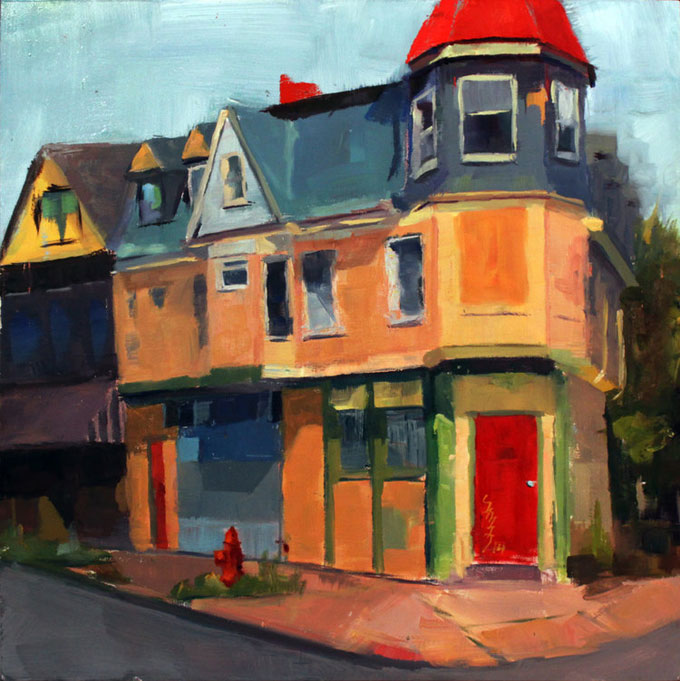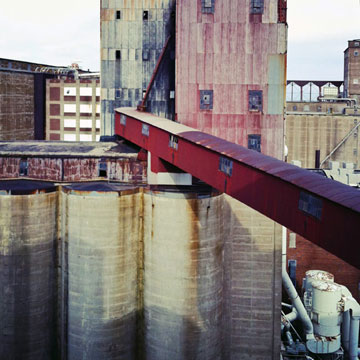Works by Three Buffalonians on Display at Studio Hart
by Jack Foran

Hometown Images
Works of three artists on a common theme of Buffalo as a work in progress are currently on view at Studio Hart, 65 Allen Street. The artists are painter and preservationist Sara M. Zak, photographer and urbanist Chris Hawley, and retired architect and planner Carol Case Siracuse, showing pen and ink drawings and watercolors. Excellent work all around.
Zak’s paintings in oils are in a sketchy impressionist style, often of industrial architecture and trappings—barns, factories, process buildings—exteriors more than interiors—and sometimes with additional ghostly overlay/underlay sketches of technical apparatus of unexplained particular relevance, but suggesting infrastructure, the soul of the machine, and history.
Sometimes the ghost image hovers above the ostensible main subject structure, as in a work depicting what looks like the dry cleaners on Main Street across from the Tri-Main Building, a commercial operation that seems from an urban planning perspective a bit of an ad hoc—for a business with constant in and out traffic, no parking area except the sidewalk in front of the building—but that has prospered at the location—apparently—for decades. In the sky above, the faint image of another maybe spiffier rehab version of the same building, maybe replacement structure. Hard to tell what the artist may be suggesting. But whatever, the ghost images add a dimension or dimensions—in conjunction with the impressionistic indefinite quality of the basic rendering style—of problematizing—as to what is or was or could be—regarding otherwise nondescript and generally overlooked urban landscape elements.

Hawley’s photos are documentary shots no doubt somehow related to his work in City Hall on the team rewriting the city zoning ordinance, but moreover conveying his personal excitement about living and working in a city ever in the act of becoming. Being part of the process. A city tenacious of its history, but looking to the future.
Most of the photos are of ancient Buffalo artifacts still around—some just—such as the long-abandoned but nonetheless impressive Central Terminal building on the East Side. A view along a rubble-strewn trackside passageway. Another of the remarkably pristine-looking kiosk clock framed against a magnificent Baths of Caracalla arch window.
Another of the three-silo GLF elevator undergoing demolition—each of the silos partially destroyed by the wrecking ball—looking a little like a three-bay Italian Romanesque church.
A photo called Wonder is of railroad tracks foreground, in the background the remains of the old red brick Wonder Bread factory off Genesee Street, still bearing a sign on the roof, the part of the sign in the picture reading “WO DER.”
In a statement accompanying his work, Hawley says he hesitates to call himself an artist, but “what I will say is that Buffalo has an amazing story to tell, and I have used photography as a way of telling it. Everywhere I turn, the city speaks. Whether it’s a tavern, tenement, or tannery, a human story is revealed in dramatic tones...How neat it has been to watch and capture a new Buffalo grow from the old.”

Siracuse gives credit where credit is due, with notations on the title labels of her paintings and drawings “inspired by” a photograph, and the name of the photographer. For example, a sketch drawing of the 600 block of Main Street during the peak disruption period of the reconstruction project to reintroduce motor vehicle traffic, based on a photo by Barbara Campagna. The west side of the street particularly sketchy, where the makeover chaos would have been concentrated at the time.
Or her watercolor of a cornice section of the Louis Sullivan Prudential Building, based on a photo by Chuck LaChiusa. Siracuse’s watercolors are stunning, and this one in particular. Kaleidoscope spectacle of shimmering light effects. Flecks of warm and bright earth colors. Everything iridescent. Louis Sullivan would admire.
Other watercolors—sometimes over pen and ink drawings, sometimes not—include a view down Ohio Street toward the lift bridge and grain elevators looming over two-story frame houses, and one of Canalside, the end of the Commercial Slip, where it flows into the Buffalo River and harbor proper.
One in the Cobblestone District, looking down Illinois Street toward the back end of the Hi-Temp Building, featuring Carly Hill’s wall sculpture depiction of the old Michigan Street lift bridge.
The Zak-Hawley-Siracuse display continues through January 31.
blog comments powered by Disqus
|
Issue Navigation> Issue Index > v14n3 (Week of Thursday, January 22) > Works by Three Buffalonians on Display at Studio Hart This Week's Issue • Artvoice Daily • Artvoice TV • Events Calendar • Classifieds |









 Current Issue
Current Issue